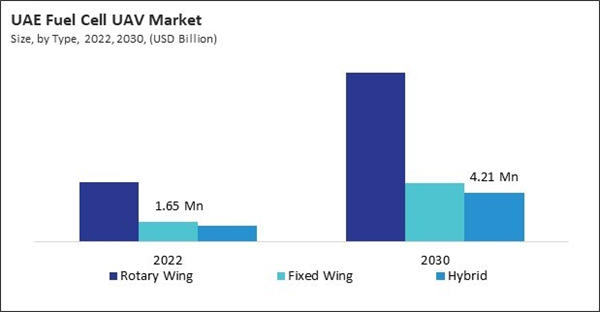The Brazil market dominated the LAMEA Fuel Cell UAV Market by Country in 2022, and would continue to be a dominant market till 2030; thereby, achieving a market value of $79.4 million by 2030. The Argentina market is showcasing a CAGR of 15.5% during (2023 - 2030). Additionally, The UAE market would register a CAGR of 14.1% during (2023 - 2030).
Fuel cell-powered UAVs boast extended range and payload capacities, enabling them to transport larger quantities of goods over longer distances. This capability is particularly beneficial for reaching remote or isolated communities where traditional delivery methods may be inefficient or impractical. By leveraging their extended range and payload capacities, fuel cell-powered UAVs can deliver essential supplies, medical equipment, and emergency aid to areas inaccessible by road or inaccessible during adverse weather conditions or natural disasters.
In addition, fuel cell-powered UAVs are utilized for surveillance and security applications, including border patrol, perimeter monitoring, and law enforcement operations. With their silent operation and long-endurance capabilities, these UAVs provide law enforcement agencies and security personnel with enhanced situational awareness and aerial reconnaissance capabilities, enabling proactive crime prevention and rapid response to security threats.
The UAE is known for its iconic skyline, featuring skyscrapers, luxury hotels, and residential towers. Particularly, Dubai and Abu Dhabi have experienced an upsurge in real estate construction, which has attracted international investors and developers. As per the Dubai Statistics Center, in 2022, there were 13,236 buildings under construction in Dubai and 1,941 completed buildings. Rapid urbanization has increased demand for housing, commercial spaces, and public amenities. Cities like Dubai and Abu Dhabi have grown substantially, requiring more infrastructure and real estate developments. Hence, the expansion of the construction sector in LAMEA will benefit the growth of the regional market.
Based on Weight, the market is segmented into Less Than 50 Kg, and More Than 50 Kg. Based on Product Type, the market is segmented into Hydrogen Fuel Cell, Proton Exchange Membrane Fuel Cell, and Solid Oxide Fuel Cell. Based on Application, the market is segmented into Civil & Commercial, Military & Defence, Logistics & Transportation, Construction & Mining, and Others. Based on Type, the market is segmented into Rotary Wing, Fixed Wing, and Hybrid. Based on End-Use, the market is segmented into Cargo UAV, and Others. Based on countries, the market is segmented into Brazil, Argentina, UAE, Saudi Arabia, South Africa, Nigeria, and Rest of LAMEA.
List of Key Companies Profiled
- Doosan Corporation
- Elbit Systems Ltd.
- The Boeing Company
- Northrop Grumman Corporation
- Textron, Inc.
- AeroVironment, Inc.
- Barnard Microsystems Ltd.
- Horizon Fuel Cell Technologies
- ISS Aerospace
- Plug Power, Inc. (EnergyOR)
Market Report Segmentation
By Weight- Less Than 50 Kg
- More Than 50 Kg
- Hydrogen Fuel Cell
- Proton Exchange Membrane Fuel Cell
- Solid Oxide Fuel Cell
- Civil & Commercial
- Military & Defence
- Logistics & Transportation
- Construction & Mining
- Others
- Rotary Wing
- Fixed Wing
- Hybrid
- Cargo UAV
- Others
- Brazil
- Argentina
- UAE
- Saudi Arabia
- South Africa
- Nigeria
- Rest of LAMEA
Table of Contents
Companies Mentioned
- Doosan Corporation
- Elbit Systems Ltd.
- The Boeing Company
- Northrop Grumman Corporation
- Textron, Inc.
- AeroVironment, Inc.
- Barnard Microsystems Ltd.
- Horizon Fuel Cell Technologies
- ISS Aerospace
- Plug Power, Inc. (EnergyOR)
Methodology

LOADING...









